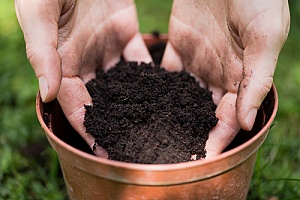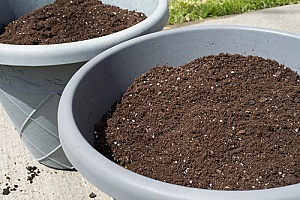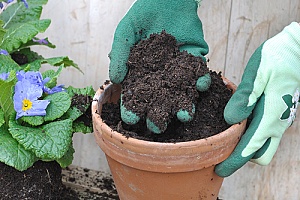 With the gardening season now over, you may find yourself wondering what to do with all the leftover potting soil you have. It seems wasteful to throw it out, and you could use the remaining soil during the next gardening season. Therefore, it is important to understand how to store potting soil.
With the gardening season now over, you may find yourself wondering what to do with all the leftover potting soil you have. It seems wasteful to throw it out, and you could use the remaining soil during the next gardening season. Therefore, it is important to understand how to store potting soil.
Most people do not spend much time wondering about how to store potting soil the correct way. After all, it’s just soil, what could go wrong? Most people would probably just stack the bags of soil in their garage and be done with it. That may not be an ideal choice of storage, though, and you could run into some problems.
Problems With Storing Potting Soil
You may still be wondering what could possibly go wrong with storing potting soil improperly over the winter. As it turns out, a lot more than you think. The most obvious problem you will want to avoid is spills. Simply stacking the bags in the garage or the basement is definitely not a guaranteed way to prevent messy spills. The bags can break or people can accidentally tear them, causing spills that are a pain to clean.
Potting Soil is Different Than Topsoil
Since the world is literally covered in soil, it is understandable that you may not think your potting soil needs any special treatment. Potting soil is different from the topsoil that covers your yard, though.
Potting soil is specially mixed to be a very loose mixture with excellent drainage and a lot of nutrients to boost plant growth. In addition to the dirt itself, potting soil will usually include a blend of other ingredients like coconut fiber, shredded tree bark, sphagnum moss, vermiculite, permite and even sand. That is why potting soil is more expensive than topsoil. It is made and mixed to create a specific type of environment that is conducive to the health and growth of potted plants. That means that it cannot be treated like regular dirt.
Contamination Is Very Possible
You also need to be concerned about contamination of the soil. Potting soil is full of organic material, which makes it a perfect place for insects to live and breed during the cold winter months. If you do not store your soil properly, you could easily find it full of bugs in the spring. It can also harbor mold and mildew spores, which will spread to your plants and kill them when you try to garden in the new year. Either of these problems can easily ruin your expensive potting soil, forcing you to go out and buy more.
Steps For Storing Potting Soil In Winter
 There are a few (but extremely important) steps for storing potting soil if you plan to use it the next year. While it may seem like it can just go back into the original bag it came from, it would not retain its nutrients and composition if it is not kept in an air-tight container. Here are the steps on how to store potting soil in the winter:
There are a few (but extremely important) steps for storing potting soil if you plan to use it the next year. While it may seem like it can just go back into the original bag it came from, it would not retain its nutrients and composition if it is not kept in an air-tight container. Here are the steps on how to store potting soil in the winter:
Let The Soil Dry Before Storing It
Moisture is the enemy when storing potting soil, so before you add your soil to the container, it is a good idea to let the soil dry before storing it. Keep the container open to the air for several days, giving the soil a good stir once a day or so to let as much moisture as possible evaporate.
When you are sealing the container, check to see if it has a rubberized seal around the lid. If it does, that will be sufficient to completely seal the container and prevent contamination. If it does not, you will need to seal the container yourself.
Fortunately, this can be easily done with duct tape. Simply use the duct tape to wrap the lid and tape it to the container, leaving no gaps at all between strips of tape. This will create an air- and water-tight seal around the container.
Use High-Quality Containers
The next step in ensuring that your potting soil remains in good condition over the winter is investing in good containers. Do not simply store your soil in the bags it was sold in. Those bags are not meant for long-term storage. They tear easily and they are neither water- nor airproof, meaning they will do a very poor job of keeping the soil from being contaminated and/or spilled. What you really want for the job is a hard-sided, waterproof container.
Plastic totes are ideal. They are affordable, durable and can hold a lot of soil. Wood or ceramic will let too much moisture in, and it is difficult to find a large enough metal container for a reasonable price.
Once you have picked out your container, give it a thorough cleaning with a mixture of bleach and water. Once you are done, do not rinse it out. Let it air-dry instead, and be sure to let it dry completely before you add your soil to it.
Store The Container In A Proper Location
Believe it or not, storing the container in the proper location is almost as important as using the proper container in the first place.
The most important thing is to store it in a dry area. Kitchens get more humid than you probably realize, and basements get damp easily. Storing the containers outside is likewise a bad idea, as the humidity levels or an untimely rainstorm could ruin your soil.
The garage or a spare bedroom is ideal since these areas tend to stay dry. The temperature isn’t especially important, as the soil will be fine in almost any temperature as long as it stays dry.
Other Gardening Storage For Winter
 There is more to gardening than potting soil, of course. If your garden has done well, you will have some seeds to store through the winter. You might even have seeds left in the original packaging.
There is more to gardening than potting soil, of course. If your garden has done well, you will have some seeds to store through the winter. You might even have seeds left in the original packaging.
Storing Seeds
Seeds are very durable, but only when stored properly. Done right, though, you can store seeds for years and still see 100% germination. If you are saving your own seeds, place them in a standard paper envelope. If you are storing store-bought seeds, keep them in the original packaging.
Mark the date on each envelope, and place it in a plastic bag. Store them in a cool, dry space. For seeds from plants that would naturally experience below-freezing weather in the winter, you can even store them in the freezer.
Storing Gardening Tools
Gardening tools also need proper storage. First, clean them thoroughly. By the end of the gardening season, most of your tools will probably be coated in a layer of dirt and grime, and the sooner you remove it the better.
Once the tools are clean, it is a good idea to coat them in a thin layer of mineral oil or vegetable oil. This can be done by pouring the oil onto a paper towel and then using the paper towel to spread a thin layer of the oil over the tools.
Learn More About How to Store Potting Soil the Right Way
The oil will prevent the tools from rusting over the winter, but it is still a good idea to store them somewhere dry to be sure they remain in good condition.
For more tips and information on how to store potting soil or other planting materials over the winter, contact the professionals at Dirt Connections today.









































